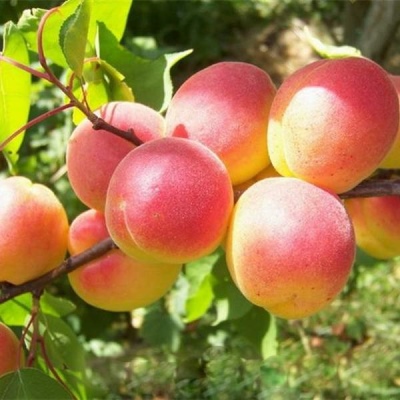
- Authors: I.L. Baikalov (Republic of Khakassia)
- Year of approval: 2002
- Tree height, m: 3
- Escapes: straight, red, medium thickness
- Flowers: medium
- Fruit shape: rounded, slightly compressed laterally
- Skin : with slight pubescence
- Fruit color: from yellow-green to yellow
- Pulp color : orange
- Pulp (consistency): dense, medium juiciness
More recently, the question of whether it is possible to grow an apricot in Siberia was strange and inappropriate - it seemed that the harsh climatic conditions in this part of the country were not at all suitable for the thermophilic tree. But through the efforts of breeders, the impossible becomes quite possible and even successful. A good result in this case will depend on the choice of the variety. The main thing is that he is winter-hardy, fertile, and has good health. And such a variety is rightfully considered the Sayan apricot.
Breeding history
An amazing variety appeared a long time ago, in 1979, on a simple personal plot in a garden located in the Republic of Khakassia. Its author is the famous Siberian gardener and breeder, enthusiast, honored agronomist of Russia Ivan Leontyevich Baikalov, who devoted more than half a century of his life to the idea of creating an apricot for Siberian orchards. It is he who owns the authorship of the first varieties of Siberian apricots: East Siberian, Gorny Abakan, Sibiryak Baikalova and, of course, Sayanskiy - such an achievement was even included in the Russian Book of Records.
As for the Sayan apricot, it was obtained on the basis of a mixture of seedlings of the 2nd generation of Khabarovsk selective forms. A promising variety was included in the State Register in 2002. Recommended for cultivation in the East Siberian region, in the Khabarovsk and Krasnoyarsk regions, the Republic of Khakassia.
Description of the variety
Sayan apricot is not a very tall tree, mostly 3 meters tall. Crohn with a diameter of 3.5 meters, sprawling, in the shape of a ball, medium thickening. The upright shoots are red in color, their thickness is medium.
Leaflets are smooth, rounded or ovate, elongated apex, dark green, large serrate margins. The placement of fruit buds is varied - they are found both on bouquet branches and on 1-year-old shoots, the sizes are medium, the shape is usual. The flowers are medium in size.
Fruit characteristics
Sayan apricot fruits look very appetizing. They are yellow, sometimes yellow-green, there is a faint blush, with a slight downy. In the bulk, they have a weight in the range of 25-35 grams. The rounded shape differs in that it is slightly compressed at the sides. The fetal suture is clearly visible.
Taste qualities
The pulp is beautiful orange in color, juicy, dense, sweet and sour taste, medium-term. In general, the taste is pleasant, the tasters gave a rating of 4.5 points.
The product contains:
- dry matter - 14%;
- sugar - 6.5%;
- acid - 2.1%;
- vitamin C - 8 mg /%.
The bone inside the pulp separates well from it. Apricots are universal, perfect for processing.
Ripening and fruiting
The Sayan variety is early in terms of ripening. Flowering of trees starts at the end of the first decade of May, duration is 10 days. Harvesting can be scheduled for mid-August. The culture begins to bear fruit already in the 3rd season.

Yield
Sayan apricot is able to bring 64 kg / ha. On average, 17 kg of fruits are harvested from one tree, and the maximum yield is fixed at 45 kg.
Self-fertility and the need for pollinators
Sayan requires cross-pollination. To do this, it will be good to plant next to such varieties as Gorny Abakan, Sibiryak Baikalova, Kirovets.
Growing and care
Growing an apricot tree in Siberia is not at all as difficult as it seems at first glance. True, efforts are still needed. The main thing is to choose a suitable variety, such as Sayan.
It is important to use high-quality and healthy seedlings when planting the described variety. The place for planting must also be chosen, taking into account the peculiarities of the culture. So, a prerequisite - the place should be illuminated by the sun's rays, but at the same time be closed from the cold wind.
Sayansky should not be planted in the shade - trees grow poorly and give a poor harvest. It is impossible to allocate a site for planting a crop in a lowland where water will accumulate. The ideal location is an elevation where groundwater is far from the surface.
If a garden is planted, the distance between the trees should be kept about 5 m, so the seedlings will not interfere with each other.
It is impossible to grow an apricot, regardless of the area, without using crown pruning. Regularly carrying out the procedure will save the plant from ailments, protect it from bad weather, and increase the yield.
Closer to winter, the Sayan apricot must be cooked. Covering measures include mulching the trunk circle, whitewashing the trunk, and when the cold comes, shovel snow for additional protection.




Winter hardiness and the need for shelter
Of course, Sayansky has high frost resistance. However, there is an instability in relation to damping off. During the winter thaws, the fruit buds that are laid on the bouquet branches can come out of dormancy, so they freeze, while the buds on the strong annual shoots remain unharmed.































































